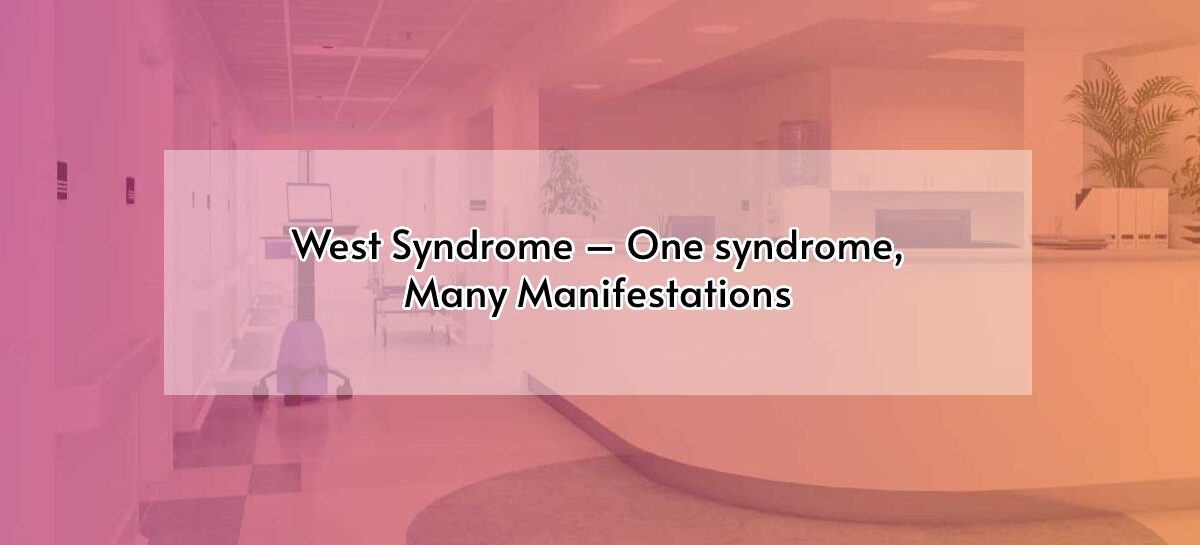Dear Colleagues,
Doctors’ Day greetings from our IMA Chennai Kauvery Alwarpet branch! This month we present elegant contributions from the Department of Pediatrics and Pediatric Surgery.
As a specialty, I have always found Pediatrics truly fascinating and challenging even as an undergraduate. So, 13 years back, I chose to become an MD with an impact and aren’t I glad! Holistic practice, fulfilment, life experiences galore; it is a true privilege to care for children.
At Kauvery, ours is a team of passionate doctors who swear and live by this very dogma. As a department, we have won the trust and goodwill of patients, families and the medical fraternity. I am eternally grateful to the management for their unstinted support in our journey. We are happy to showcase our work and hope the readers find the articles useful and enriching!
Dr Lakshmi Prashanth MD
Case Scenario
A 2-year-old boy, a known case of Global developmental delay/HIE sequelae/Symptomatic West syndrome presented to the emergency room with status epilepticus (semiology – GTCS) after being spasms-free for a year. In the past, he had received hormonal therapy (6 weeks of oral prednisolone regimen) in infancy and was on multiple AEDs for seizure control.
In the current admission, he also had clinical features suggestive of aspiration including tachypnea, hypoxemia, chest retractions and crackles on auscultation. Emergent measures for status epilepticus were instituted including prompt establishment of IV access followed by loading dose of levetiracetam, airway protective measures, clearance of nasal and oropharyngeal secretions and supplemental oxygen at 5 L/min. Following initial stabilization, the child was shifted to the ICU for HFNC support in view of increased work of breathing secondary to aspiration. Chest radiograph done showed classical right sided infiltrates (hilar and basal). He was started on broad spectrum IV piperacillin tazobactam (including cover for anaerobes) and respiratory supportive care measures (inhaled bronchodilators, hypertonic saline, positioning, gentle chest physiotherapy and suctioning, anti-reflux measures). He was weaned off HFNC in 72 hours to low flow oxygen. His regular anti-epileptic drugs (clonazepam/zonisamide) were concurrently administered with upward titration of levetiracetam to 30 mg/kg/day in order to achieve seizure control. NG feeding was initiated after stabilization of respiratory status on Day 3 of admission followed by transitioning to oral feeding (Keto diet) on Day 5. He was moved to ward on Day 6 and discharged on Day 7.
Discussion
West Syndrome goes popularly by the classical triad of infantile spasms, hypsarrhythmia and mental retardation. However current concepts describe it as a syndrome with epileptiform encephalopathy with varying subtypes, different aetiologies, manifestations and prognoses. The term “infantile spasms” is now referred to as “epileptic spasms”. These spasms can be focal or generalized and usually manifest between 3 to 12 months of age. At the onset in infancy, these patients classically present with clusters of spasms (particularly on arousal from sleep), developmental impacts and visual/hearing problems. Atypical electroclinical phenotypes with onset after infancy and several seizure types (myoclonic seizures, atonic seizures, generalized and partial seizures) can be associated with this epilepsy syndrome as well.
Current classification of West syndrome is as follows:
⦁ Symptomatic (Perinatal insults/Structural/Genetic or Metabolic)
⦁ Cryptogenic
⦁ Idiopathic
More than 200 causes have been identified in the aetiology of ES. Some of these are –
⦁ Hypoxic ischemic encephalopathy, maternal toxaemia, meningitis, encephalitis, transplacental infections.
⦁ Neurocutaneous disorders (Tuberous sclerosis, neurofibromatosis, Incontinentia pigmenti, Sturge Weber Syndrome, Epidermal Nevus syndrome)
⦁ Structural lesions (Aicardi syndrome, Agenesis of corpus callosum, Cortical dysplasias)
⦁ Neuro metabolic causes (PKU, Maple Syrup Urine disease, Biotinidase deficiency, Menke’s disease)
⦁ Genetic causes -Pathogenic mutations may be identified in 25 to 30% of patients.
Diagnosis of ES requires thorough history taking, detailed physical examination, comprehensive neurological assessment, a full video EEG recording and neuroimaging (optimum epilepsy protocol being the minimum standard). EEG is extremely crucial in the diagnosis. Hypsarrhythmia describes the classical inter-ictal EEG pattern with chaotic, disorganized high voltage slow waves and spikes. Variant or Modified hypsarrhythmia includes rapid, slow, asymmetric, unilateral or burst suppression pattern.
In clinically relevant settings, genetic testing (whole/clinical exome sequencing) and metabolic testing (Acyl carnitine profile, Serum and CSF lactate/pyruvate, Urine organic acids, Serum and CSF amino acids and CSF neurotransmitters) are performed. Treatment options (Table 1) involves Hormonal therapy, AEDs and others (Ketogenic diet and epilepsy surgery).

Hormonal therapy is the first line of treatment in ES. The AOCN-IES consensus statement on WS, 2019 recommends that both ACTH and high dose prednisolone have reasonably similar efficacy and adverse effect profile. Among the AEDs, Vigabatrin is the drug of choice especially in Tuberous Sclerosis. The other commonly used effective choices include levetiracetam, topiramate, zonisamide, clonazepam, clobazam and nitrazepam.
These children have associated functional problems in view of poor oro-motor skills, oro-pharyngeal incoordination, reflux, recurrent aspirations, weak airway protective reflexes and hypotonia. These are additional factors that result in their hospital admissions apart from seizures/status as in this case.
Children with ES require holistic care under a multi-disciplinary team comprising of a pediatrician, pediatric neurologist, developmental pediatrician and rehab personnel (physiotherapist, OT, speech therapist, dietician). Adverse neurodevelopmental outcomes can be minimised with early diagnosis, prompt treatment and regular follow up.
 Dr Lakshmi Prashanth
Dr Lakshmi Prashanth
Consultant Pediatrician
Kauvery Hospital Chennai



